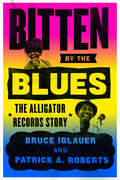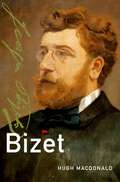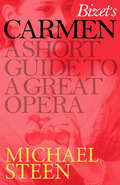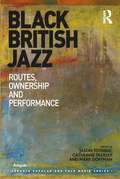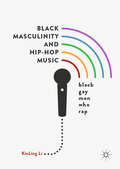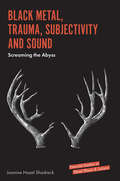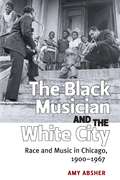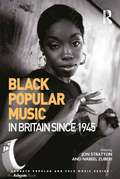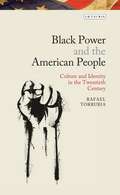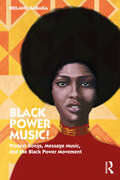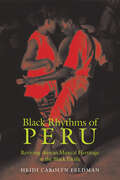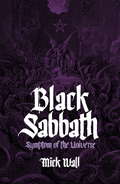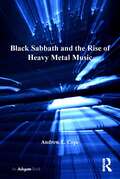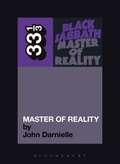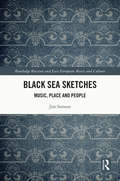- Table View
- List View
Bitten by the Blues: The Alligator Records Story (Chicago Visions and Revisions)
by Bruce Iglauer Patrick A. RobertsIt started with the searing sound of a slide careening up the neck of an electric guitar. In 1970, twenty-three-year-old Bruce Iglauer walked into Florence’s Lounge, in the heart of Chicago’s South Side, and was overwhelmed by the joyous, raw Chicago blues of Hound Dog Taylor and the HouseRockers. A year later, Iglauer produced Hound Dog’s debut album in eight hours and pressed a thousand copies, the most he could afford. From that one album grew Alligator Records, the largest independent blues record label in the world. Bitten by the Blues is Iglauer’s memoir of a life immersed in the blues—and the business of the blues. No one person was present at the creation of more great contemporary blues music than Iglauer: he produced albums by Koko Taylor, Albert Collins, Professor Longhair, Johnny Winter, Lonnie Mack, Son Seals, Roy Buchanan, Shemekia Copeland, and many other major figures. In this book, Iglauer takes us behind the scenes, offering unforgettable stories of those charismatic musicians and classic sessions, delivering an intimate and unvarnished look at what it’s like to work with the greats of the blues. It’s a vivid portrait of some of the extraordinary musicians and larger-than-life personalities who brought America’s music to life in the clubs of Chicago’s South and West Sides. Bitten by the Blues is also an expansive history of half a century of blues in Chicago and around the world, tracing the blues recording business through massive transitions, as a genre of music originally created by and for black southerners adapted to an influx of white fans and musicians and found a worldwide audience. Most of the smoky bars and packed clubs that fostered the Chicago blues scene have long since disappeared. But their soul lives on, and so does their sound. As real and audacious as the music that shaped it, Bitten by the Blues is a raucous journey through the world of Genuine Houserockin’ Music.
Bizet (Master Musicians Series)
by Hugh MacdonaldToday Georges Bizet is most immediately recognized as the composer of the acclaimed opera Carmen. One of the most frequently performed operas for over a century, Carmen explores concepts such as the femme fatale and murderous jealousy with vivacity, color, and a wealth of melody. Yet it is only one act in Bizet's story. In Bizet, renowned musicologist Hugh Macdonald goes beyond the composer's most famous opera to take an in-depth look at his entire life and oeuvre. In so doing, Macdonald identifies a number of previously unknown pieces by Bizet, assembling the first comprehensive catalogue of the composer's work. Incorporating these little-known pieces with a thorough reading of primary sources, Macdonald considers the latest in Bizet scholarship to create a complete biography of the composer. Revealing the true extent of Bizet's work as arranger and transcriber, Macdonald sheds light on the composer's complex relationships with his contemporaries, and traces the strange misrepresentation of Bizet's work by French publishers and opera houses in the 1880s, when Carmen rose to worldwide popularity ten years after the composer's early death. The first biography of Bizet in the Master Musicians series in nearly four decades, Bizet will be essential reading for students and scholars of nineteenth-century opera, as well as for Carmen devotees and opera fans.
Bizet (Master Musicians Series)
by Hugh MacdonaldToday Georges Bizet is most immediately recognized as the composer of the acclaimed opera Carmen. One of the most frequently performed operas for over a century, Carmen explores concepts such as the femme fatale and murderous jealousy with vivacity, color, and a wealth of melody. Yet it is only one act in Bizet's story. In Bizet, renowned musicologist Hugh Macdonald goes beyond the composer's most famous opera to take an in-depth look at his entire life and oeuvre. In so doing, Macdonald identifies a number of previously unknown pieces by Bizet, assembling the first comprehensive catalogue of the composer's work. Incorporating these little-known pieces with a thorough reading of primary sources, Macdonald considers the latest in Bizet scholarship to create a complete biography of the composer. Revealing the true extent of Bizet's work as arranger and transcriber, Macdonald sheds light on the composer's complex relationships with his contemporaries, and traces the strange misrepresentation of Bizet's work by French publishers and opera houses in the 1880s, when Carmen rose to worldwide popularity ten years after the composer's early death. The first biography of Bizet in the Master Musicians series in nearly four decades, Bizet will be essential reading for students and scholars of nineteenth-century opera, as well as for Carmen devotees and opera fans.
Bizet's Carmen: A Short Guide to a Great Opera (Great Operas)
by Michael SteenThe Paris audience in 1875 was shocked by the sexually explicit realism of Bizet’s exotic operatic masterpiece, its ‘verismo’ depiction of low life and brutal passion. But since the disastrous première – a sensational failure which hastened Bizet’s premature death – it has been the greatest operatic success. It led to a film opera, a jazz opera, a rock ballet and a Broadway musical. Equally, it impressed great composers including Tchaikovsky, Brahms and Vaughan Williams. The story, written by Prosper Mérimée and adapted by librettists Meilhac and Halévy, is set in colourful Seville, in southern Spain, renowned for bullfights. The corporal Don José is seduced by Carmencita, a gypsy whore who works in a tobacco factory. With her Habanera (a Cuban dance like the tango) and Andalusian Seguidilla, she charms him, and escapes prison. She falls for Escamillo, a celebrity toreador associated with the famous tune Toréador en garde. Don José’s Flower Song fails to win her for long. We visit the haunt of Seville’s demi-monde, Lillas Pastia’s bodega, and a gypsy encampment in the mountains, before José stabs Carmen outside the bullring. Written by Michael Steen, author of the acclaimed The Lives and Times of the Great Composers, ‘Short Guides to Great Operas’ are concise, entertaining and easy to read. They are packed with useful information and informed opinion, helping to make you a truly knowledgeable opera-goer, and so maximising your enjoyment of a great musical experience. Other ‘Short Guides to Great Operas’ that you may enjoy include Tosca, Madama Butterfly and Eugene Onegin.
Björk's Homogenic (33 1/3)
by Emily MackayIn recent years, Björk's artistry has become ever more ambitious and ever more respected. With the release of her conceptual app-album Biophilia in 2011, and a huge retrospective exhibition at New York's Museum of Modern Art coinciding with her most recent album, Vulnicura, in 2015, her status as artpop auteur has been secured. The album that made all this possible, though is 1997's Homogenic, a turning point in Björk's career and still among her finest musical achievements. Produced under great strain, it moves beyond the stylistic magpie rush of Debut and the urbanophile future-pop of Post, to something darker, stronger and braver, full of dramatic assertions of independence, sharp, stuttering beats, rich strings and raw outbursts of noise. It created, as the Alexander McQueen designed sleeve clearly asserted, a new Björk, one who would never stop hunting.
Björk's Homogenic (33 1/3)
by Emily MackayIn recent years, Björk's artistry has become ever more ambitious and ever more respected. With the release of her conceptual app-album Biophilia in 2011, and a huge retrospective exhibition at New York's Museum of Modern Art coinciding with her most recent album, Vulnicura, in 2015, her status as artpop auteur has been secured. The album that made all this possible, though is 1997's Homogenic, a turning point in Björk's career and still among her finest musical achievements. Produced under great strain, it moves beyond the stylistic magpie rush of Debut and the urbanophile future-pop of Post, to something darker, stronger and braver, full of dramatic assertions of independence, sharp, stuttering beats, rich strings and raw outbursts of noise. It created, as the Alexander McQueen designed sleeve clearly asserted, a new Björk, one who would never stop hunting.
Black British Jazz: Routes, Ownership and Performance (Ashgate Popular and Folk Music Series)
by Jason Toynbee Catherine TackleyBlack British musicians have been making jazz since around 1920 when the genre first arrived in Britain. This groundbreaking book reveals their hidden history and major contribution to the development of jazz in the UK. More than this, though, the chapters show the importance of black British jazz in terms of musical hybridity and the cultural significance of race. Decades before Steel Pulse, Soul II Soul, or Dizzee Rascal pushed their way into the mainstream, black British musicians were playing jazz in venues up and down the country from dance halls to tiny clubs. In an important sense, then, black British jazz demonstrates the crucial importance of musical migration in the musical history of the nation, and the links between popular and avant-garde forms. But the volume also provides a case study in how music of the African diaspora reverberates around the world, beyond the shores of the USA - the engine-house of global black music. As such it will engage scholars of music and cultural studies not only in Britain, but across the world.
Black British Jazz: Routes, Ownership and Performance (Ashgate Popular and Folk Music Series)
by Jason Toynbee Catherine TackleyBlack British musicians have been making jazz since around 1920 when the genre first arrived in Britain. This groundbreaking book reveals their hidden history and major contribution to the development of jazz in the UK. More than this, though, the chapters show the importance of black British jazz in terms of musical hybridity and the cultural significance of race. Decades before Steel Pulse, Soul II Soul, or Dizzee Rascal pushed their way into the mainstream, black British musicians were playing jazz in venues up and down the country from dance halls to tiny clubs. In an important sense, then, black British jazz demonstrates the crucial importance of musical migration in the musical history of the nation, and the links between popular and avant-garde forms. But the volume also provides a case study in how music of the African diaspora reverberates around the world, beyond the shores of the USA - the engine-house of global black music. As such it will engage scholars of music and cultural studies not only in Britain, but across the world.
Black Masculinity and Hip-Hop Music: Black Gay Men Who Rap
by Xinling LiThis book offers an interdisciplinary study of hip-hop music written and performed by rappers who happen to be out black gay men. It examines the storytelling mechanisms of gay themed lyrics, and how these form protests and become enabling tools for (black) gay men to discuss issues such as living on the down-low and HIV/AIDS. It considers how the biased promotion of feminised gay male artists/characters in mainstream entertainment industry has rendered masculinity an exclusively male heterosexual property, providing a representational framework for men to identify with a form of “homosexual masculinity” – one that is constructed without having to either victimise anything feminine or necessarily convert to femininity. The book makes a strong case that it is possible for individuals (like gay rappers) to perform masculinity against masculinity, and open up a new way of striving for gender equality.
Black Metal, Trauma, Subjectivity and Sound: Screaming the Abyss (Emerald Studies in Metal Music and Culture)
by Jasmine Hazel ShadrackBlack Metal, Trauma, Subjectivity and Sound: Screaming the Abyss weaves together trauma, black metal performance and disability into a story of both pain and freedom. Drawing on her years as a black metal guitarist, Jasmine Hazel Shadrack uses autoethnography to explore her own experiences of gender-based violence, misogyny, and the healing power of performance. This profoundly personal book offers a detailed explanation of autoethnography, followed by a careful exposition of the relationship between metal and gender, considering - among other things - how women are engaged with by metal music culture. After examining the various waves of black metal and how this has impacted black metal theory, the book moves on to consider female performers and performance as catharsis, including a discussion of the author's work as guitarist and vocalist with the black metal band Denigrata and her alter-ego, the 'antlered priestess' Denigrata Herself. The book concludes with some thoughts on acquired disability, freedom and peace. The book includes a foreword from eminent gender researcher Rosemary Lucy Hill, a guest section from metal scholar Amanda DiGioia, an epilogue from Rebecca Lamont-Jiggens (a legal pracademic specialising in disability), suggestions of sources of help for those in abusive relationships and further reading for those wishing to learn more about black metal theory.
Black Metal, Trauma, Subjectivity and Sound: Screaming the Abyss (Emerald Studies in Metal Music and Culture)
by Jasmine Hazel ShadrackBlack Metal, Trauma, Subjectivity and Sound: Screaming the Abyss weaves together trauma, black metal performance and disability into a story of both pain and freedom. Drawing on her years as a black metal guitarist, Jasmine Hazel Shadrack uses autoethnography to explore her own experiences of gender-based violence, misogyny, and the healing power of performance. This profoundly personal book offers a detailed explanation of autoethnography, followed by a careful exposition of the relationship between metal and gender, considering - among other things - how women are engaged with by metal music culture. After examining the various waves of black metal and how this has impacted black metal theory, the book moves on to consider female performers and performance as catharsis, including a discussion of the author's work as guitarist and vocalist with the black metal band Denigrata and her alter-ego, the 'antlered priestess' Denigrata Herself. The book concludes with some thoughts on acquired disability, freedom and peace. The book includes a foreword from eminent gender researcher Rosemary Lucy Hill, a guest section from metal scholar Amanda DiGioia, an epilogue from Rebecca Lamont-Jiggens (a legal pracademic specialising in disability), suggestions of sources of help for those in abusive relationships and further reading for those wishing to learn more about black metal theory.
Black Music in Britain in the 21st Century (Liverpool Studies in the Politics of Popular Culture)
Since the turn of the 21st century, there have been several genres birthed from or nurtured in Black Britain: funky & tribal House, Afrobeats, Grime, Afro Swing, UK Drill, Road Rap, Trap etc. This pioneering book brings together diverse diasporan sounds in conversation. A valuable resource for those interested in the study of 21st century Black music and related cultures in Britain, this book goes incorporates the significant Black Atlantean, global interactions within Black music across time and space. It examines and proposes theoretical approaches, contributing to building a holistic appreciation of 21st century Black British music and its multidimensional nature. This book proffers an academically curated, rigorous, holistic view of Black British music in the 21st century. Drawing from pioneering academics in the emerging field and industry professionals, the book will serve academic theory, as well as the views, debates and experiences of industry professionals in a complementary style that shows the synergies between diasporas and interdisciplinary conversations. The book is interdisciplinary. It draws from sociology, musicology and the emerging digital humanities fields, to make its arguments and develop a multi-disciplinary perspective about Black British music in the 21st century.
The Black Musician and the White City: Race and Music in Chicago, 1900-1967
by Amy AbsherAmy Absher’s The Black Musician and the White City tells the story of African American musicians in Chicago during the mid-twentieth century. While depicting the segregated city before World War II, Absher traces the migration of black musicians, both men and women and both classical and vernacular performers, from the American South to Chicago during the 1930s to 1950s. Absher’s work diverges from existing studies in three ways: First, she takes the history beyond the study of jazz and blues by examining the significant role that classically trained black musicians played in building the Chicago South Side community. By acknowledging the presence and importance of classical musicians, Absher argues that black migrants in Chicago had diverse education and economic backgrounds but found common cause in the city’s music community. Second, Absher brings numerous maps to the history, illustrating the relationship between Chicago’s physical lines of segregation and the geography of black music in the city over the years. Third, Absher’s use of archival sources is both extensive and original, drawing on manuscript and oral history collections at the Center for Black Music Research in Chicago, Columbia University, Rutgers’s Institute of Jazz Studies, and Tulane’s Hogan Jazz Archive. By approaching the Chicago black musical community from these previously untapped angles, Absher offers a history that goes beyond the retelling of the achievements of the famous musicians by discussing musicians as a group. In The Black Musician and the White City, black musicians are the leading actors, thinkers, organizers, and critics of their own story.
Black Popular Music in Britain Since 1945 (Ashgate Popular and Folk Music Series)
by Jon Stratton Nabeel ZuberiBlack Popular Music in Britain Since 1945 provides the first broad scholarly discussion of this music since 1990. The book critically examines key moments in the history of black British popular music from 1940s jazz to 1970s soul and reggae, 1990s Jungle and the sounds of Dubstep and Grime that have echoed through the 2000s. While the book offers a history it also discusses the ways black musics in Britain have intersected with the politics of race and class, multiculturalism, gender and sexuality, and debates about media and technology. Contributors examine the impact of the local, the ways that black music in Birmingham, Bristol, Liverpool, Manchester and London evolved differently and how black popular music in Britain has always developed in complex interaction with the dominant British popular music tradition. This tradition has its own histories located in folk music, music hall and a constant engagement, since the nineteenth century, with American popular music, itself a dynamic mixing of African-American, Latin American and other musics. The ideas that run through various chapters form connecting narratives that challenge dominant understandings of black popular music in Britain and will be essential reading for those interested in Popular Music Studies, Black British Studies and Cultural Studies.
Black Popular Music in Britain Since 1945 (Ashgate Popular and Folk Music Series)
by Jon Stratton Nabeel ZuberiBlack Popular Music in Britain Since 1945 provides the first broad scholarly discussion of this music since 1990. The book critically examines key moments in the history of black British popular music from 1940s jazz to 1970s soul and reggae, 1990s Jungle and the sounds of Dubstep and Grime that have echoed through the 2000s. While the book offers a history it also discusses the ways black musics in Britain have intersected with the politics of race and class, multiculturalism, gender and sexuality, and debates about media and technology. Contributors examine the impact of the local, the ways that black music in Birmingham, Bristol, Liverpool, Manchester and London evolved differently and how black popular music in Britain has always developed in complex interaction with the dominant British popular music tradition. This tradition has its own histories located in folk music, music hall and a constant engagement, since the nineteenth century, with American popular music, itself a dynamic mixing of African-American, Latin American and other musics. The ideas that run through various chapters form connecting narratives that challenge dominant understandings of black popular music in Britain and will be essential reading for those interested in Popular Music Studies, Black British Studies and Cultural Studies.
Black Power and the American People: Culture and Identity in the Twentieth Century (Library of Modern American History)
by Rafael TorrubiaWhile the history of the Civil Rights Movement, from Rosa Parks to Martin Luther King, is one of the great American stories of the twentieth century, the related Black Power movement has left a more complex legacy. Its original leaders, Stokely Carmichael and Willie Ricks, were Black Nationalists, advocating a militant and extremist approach to tackle racism, while other leaders, such as Bobby Seale of the Black Panthers, believed that the struggle for Black Power was essentially a class struggle. Beginning with the folk-narratives told through song by slaves in the plantations, through the Harlem renaissance of the 1920s and 30s, the era of Malcolm X, the African-American art and fashion of the late sixties and 'soul music' and politics in the 1970s, Black Power and the American People will be the first comprehensive cultural history of the movement.
Black Power Music!: Protest Songs, Message Music, and the Black Power Movement
by Reiland RabakaBlack Power Music! Protest Songs, Message Music, and the Black Power Movement critically explores the soundtracks of the Black Power Movement as forms of "movement music." That is to say, much of classic Motown, soul, and funk music often mirrored and served as mouthpieces for the views and values, as well as the aspirations and frustrations, of the Black Power Movement. Black Power Music! is also about the intense interconnections between Black popular culture and Black political culture, both before and after the Black Power Movement, and the ways in which the Black Power Movement in many senses symbolizes the culmination of centuries of African American politics creatively combined with, and ingeniously conveyed through, African American music. Consequently, the term "Black Power music" can be seen as a code word for African American protest songs and message music between 1965 and 1975. "Black Power music" is a new concept that captures and conveys the fact that the majority of the messages in Black popular music between 1965 and 1975 seem to have been missed by most people who were not actively involved in, or in some significant way associated with, the Black Power Movement.
Black Power Music!: Protest Songs, Message Music, and the Black Power Movement
by Reiland RabakaBlack Power Music! Protest Songs, Message Music, and the Black Power Movement critically explores the soundtracks of the Black Power Movement as forms of "movement music." That is to say, much of classic Motown, soul, and funk music often mirrored and served as mouthpieces for the views and values, as well as the aspirations and frustrations, of the Black Power Movement. Black Power Music! is also about the intense interconnections between Black popular culture and Black political culture, both before and after the Black Power Movement, and the ways in which the Black Power Movement in many senses symbolizes the culmination of centuries of African American politics creatively combined with, and ingeniously conveyed through, African American music. Consequently, the term "Black Power music" can be seen as a code word for African American protest songs and message music between 1965 and 1975. "Black Power music" is a new concept that captures and conveys the fact that the majority of the messages in Black popular music between 1965 and 1975 seem to have been missed by most people who were not actively involved in, or in some significant way associated with, the Black Power Movement.
Black Rhythms of Peru: Reviving African Musical Heritage in the Black Pacific (Music / Culture)
by Heidi FeldmanWinner of the IASPM's Woody Guthrie Award (2007)In the late 1950s to 1970s, an Afro-Peruvian revival brought the forgotten music and dances of Peru's African musical heritage to Lima's theatrical stages. The revival conjured newly imagined links to the past in order to celebrate—and to some extent recreate—Black culture in Peru. In this groundbreaking study of the Afro-Peruvian revival and its aftermath, Heidi Carolyn Feldman reveals how Afro-Peruvian artists remapped blackness from the perspective of the "Black Pacific," a marginalized group of African diasporic communities along Latin America's Pacific coast. Feldman's "ethnography of remembering" traces the memory projects of charismatic Afro-Peruvian revival artists and companies, including José Durand, Nicomedes and Victoria Santa Cruz, and Perú Negro, culminating with Susana Baca's entry onto the global world music stage in the 1990s. Readers will learn how Afro-Peruvian music and dance genres, although recreated in the revival to symbolize the ancient and forgotten past, express competing modern beliefs regarding what constitutes "Black Rhythms of Peru."
Black Sabbath: Symptom of the Universe
by Mick WallThe final word on the only name synonymous with heavy metal - Black Sabbath.Way back in the mists of time, in the days when rock giants walked the earth, the name Ozzy Osbourne was synonymous with the subversive and dark. Back then, Ozzy was the singer in Black Sabbath, and they meant business. A four-piece formed from the ashes of two locally well-known groups called The Rare Breed (Ozzy and bassist Geezer Butler) and Mythology (guitarist Tony Iommi and drummer Bill Ward), all four founding members of the original Black Sabbath grew up within half-a-mile of each other.This biography tells the story of how they made that dream come true - and how it then turned into a nightmare for all of them. How at the height of their fame, Sabbath discovered they had been so badly ripped off by their managers they did not even own their own songs. How they looked for salvation from Don Arden - an even more notorious gangster figure, who resurrected their career but still left them indebted to him, financially and personally. And how it finally came to a head when in 1979 they sacked Ozzy: 'For being too out of control - even for us,' as Bill Ward put it.The next 15 years would see a war break out between the two camps: the post-Ozzy Sabbath and Ozzy himself, whose solo career overshadowed Sabbath to the point where, when he offered them the chance to reform around him again, it was entirely on his terms. Or rather, that of his wife and manager, daughter of Don Arden - Sharon Osbourne.
Black Sabbath and the Rise of Heavy Metal Music
by Andrew L. CopeThe definition of 'heavy metal' is often a contentious issue and in this lively and accessible text Andrew Cope presents a refreshing re-evaluation of the rules that define heavy metal as a musical genre. Cope begins with an interrogation of why, during the late 1960s and early 1970s, Birmingham provided the ideal location for the evolution and early development of heavy metal and hard rock. The author considers how the influence of the London and Liverpool music scenes merged with the unique cultural climate, industry and often desolated sites of post-war Birmingham to contribute significantly to the development of two unique forms of music: heavy metal and hard rock. The author explores these two forms through an extensive examination of key tracks from the first six albums of both Black Sabbath and Led Zeppelin, in which musical, visual and lyrical aspects of each band are carefully compared and contrasted in order to highlight the distinctive innovations of those early recordings. In conclusion, a number of case studies are presented that illustrate how the unique synthesis of elements established by Black Sabbath have been perpetuated and developed through the work of such bands as Iron Maiden, Metallica, Pantera, Machine Head, Nightwish, Arch Enemy and Cradle of Filth. As a consequence, the importance of heavy metal as a genre of music was firmly established, and its longevity assured.
Black Sabbath and the Rise of Heavy Metal Music
by Andrew L. CopeThe definition of 'heavy metal' is often a contentious issue and in this lively and accessible text Andrew Cope presents a refreshing re-evaluation of the rules that define heavy metal as a musical genre. Cope begins with an interrogation of why, during the late 1960s and early 1970s, Birmingham provided the ideal location for the evolution and early development of heavy metal and hard rock. The author considers how the influence of the London and Liverpool music scenes merged with the unique cultural climate, industry and often desolated sites of post-war Birmingham to contribute significantly to the development of two unique forms of music: heavy metal and hard rock. The author explores these two forms through an extensive examination of key tracks from the first six albums of both Black Sabbath and Led Zeppelin, in which musical, visual and lyrical aspects of each band are carefully compared and contrasted in order to highlight the distinctive innovations of those early recordings. In conclusion, a number of case studies are presented that illustrate how the unique synthesis of elements established by Black Sabbath have been perpetuated and developed through the work of such bands as Iron Maiden, Metallica, Pantera, Machine Head, Nightwish, Arch Enemy and Cradle of Filth. As a consequence, the importance of heavy metal as a genre of music was firmly established, and its longevity assured.
Black Sabbath's Master of Reality (33 1/3)
by John DarnielleBlack Sabbath's Master of Reality has maintained remarkable historical status over several generations; it's a touchstone for the directionless, and common coin for young men and women who've felt excluded from the broader cultural economy. John Darnielle hears it through the ears of Roger Painter, a young adult locked in a southern California adolescent psychiatric center in 1985; deprived of his Walkman and hungry for comfort, he explains Black Sabbath as one might describe air to a fish, or love to an android, hoping to convince his captors to give him back his tapes.
Black Sabbath's Master of Reality (33 1/3)
by John DarnielleBlack Sabbath's Master of Reality has maintained remarkable historical status over several generations; it's a touchstone for the directionless, and common coin for young men and women who've felt excluded from the broader cultural economy. John Darnielle hears it through the ears of Roger Painter, a young adult locked in a southern California adolescent psychiatric center in 1985; deprived of his Walkman and hungry for comfort, he explains Black Sabbath as one might describe air to a fish, or love to an android, hoping to convince his captors to give him back his tapes.
Black Sea Sketches: Music, Place and People (Slavonic and East European Music Studies)
by Jim SamsonBlack Sea Sketches is a portrait of some of the diverse musical cultures surrounding the Black Sea and in its hinterlands. Its six separate chapters follow a very broad trajectory from close-ups of traditional music (chapters 1-4) towards wide-angle studies of art music (chapters 5-6), and each of them opens windows to big, border-crossing themes about music and place. A wide variety of repertoires is discussed: ancient layers of polyphonic music, bardic songs, traditional music from the coasts and mountains, the sacred music of Islam and Orthodox Christianity, the art music of Europe and West Asia, and present-day popular music ‘scenes’. The usual practice is for each chapter to begin with a Black Sea coastal location before reaching out into the hinterlands. The result is a collection of six relatively discrete essays on different locations and topics, but with underlying thematic continuities, and offering a wide-ranging commentary on cultural difference. Firmly grounded in ethnographic and documentary research, this is an important study for scholars and researchers of Ethnomusicology, as also of Caucasian and Russian/East European Studies.
